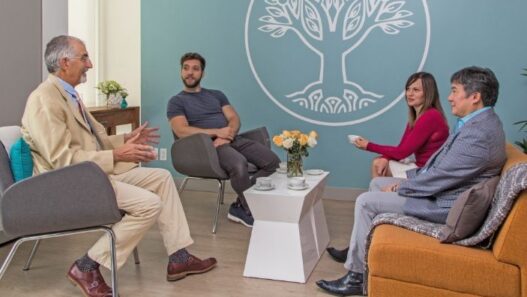
If “Learn to Meditate!“ hasn’t so far made your list of New Year’s resolutions, then “Stress Less!“ likely will. And, really, the two go hand in hand.
The New York Times best-selling author and Oprah favorite Gabrielle Bernstein knows about the connection between mental clutter and meditation from her own personal experience.
Pleasant surprises on several fronts
Bernstein, a former PR girl whose own battle with drug and alcohol addiction led to a spiritual awakening, has earned a reputation as something of an expert on the subject.
She completed the Kundalini yoga teacher training last summer and has been quick to incorporate many of these teachings into her talks and workshops. She has also studied Transcendental Meditation (TM) with the David Lynch Foundation, which she has since credited with everything from reducing stress to combating issues with her skin.

Bernstein says, “Throughout my life I had heard a lot about Transcendental Meditation. I had read about the great health benefits and energy shifts TM offered. I was curious and open. That summer I was living out at the beach and I knew that the TM teachers from the David Lynch Foundation were training people in a beach house nearby. I inquired about the training but was told it was full. Then one day out of blue I got a text from my friend Michael.
His text said, “I don’t know why but I thought you’d really like the TM four-day training. I put a call in for you and got you into a group next week!”
I was blown away by this universal hook-up and immediately replied YES! After a short four-day training I was given the gift of Transcendental Meditation.”
Watch Gabrielle Bernstein talking with Bob Roth
about Transcendental Meditation and the University of Peace:
“It turns out my skin problems were all stress related!” Bernstein says. “I also don’t suffer anxiety the way I used to, which I can directly attribute to incorporating the Transcendental Meditation practice into my life.”
Embrace your thoughts

The main thing, says Bernstein, is to be completely natural in your meditation. Big, self-conscious effort of keeping stressful thoughts forcefully at bay is nothing but counterproductive.
“When your thoughts come in, let them come,“ Bernstein explains. “Don’t push them away, deny, or try to control them. In TM, they teach that when thoughts come up a lot during meditation there’s some emotional root that needs to be healed, and that allowing them to come is part of the healing.“
The stress-busting effect therefore flows naturally from the simplicity of the technique.
“Using a mantra gives you somewhere to go—so you can be in the thought, come back to the mantra, and you keep going backwards and forwards. Whenever you catch yourself thinking, just come back to your mantra.”
Sources:
“Meditation Made Easy” by Ruby Warrington, Equinox
“A meditation practice that will change your life…” by Gabbie Bernstein



















